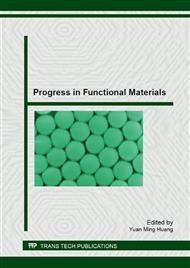p.113
p.117
p.121
p.125
p.129
p.133
p.138
p.142
p.146
Preparation and Properties of Waterborne Cationic Polyurethanes/Polypyrrole Conductive Composites
Abstract:
A series of waterborne cationic polyurethanes dispersions (CWPU) was prepared through prepolymerization method by reacting polyethylene glycol (PEG1000) and isophorone diisocyanate (IPDI) with N-methyl diethanol amine (MDEA) as chain extender. Then FeCl3 was employed as oxidant, therefore CWPU/polypyrrole (CWPU/PPy) conductive composite was prepared by in situ chemical oxidative polymerization of pyrrole (Py) in CWPU dispersions. Effects of molar ratio of FeCl3 to Py, Py concentration on the resistivity of the CWPU/PPy composite films were investigated. The structure, morphology and thermal stability were also characterized by Fourier infrared spectra (FT-IR), light scattering, TEM, and TGA. FT-IR demonstrated the presence of hydrogen-bonding interactions between CWPU and PPy. The average particle size of CWPU/PPy increased from 10.61nm to 30.29nm compared with pure PU, and corresponding size distribution decreased from 0.850 to 0.346. It was also found that CWPU/PPy displayed as spherical morphology, and no aggregation among particles was detected among particles. TGA certified CWPU/PPy was endowed with better thermal stability. In addition, conductivity stability of composites films was also studied. It was found that composite films not only displayed low resistivity but also improved conductivity stability.
Info:
Periodical:
Pages:
129-132
Citation:
Online since:
January 2013
Authors:
Price:
Сopyright:
© 2013 Trans Tech Publications Ltd. All Rights Reserved
Share:
Citation:


